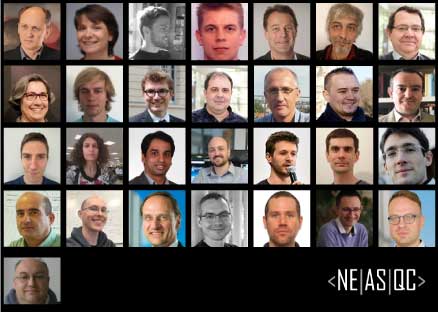Les Clayes, France — 5 October, 2020 — The NExt ApplicationS of Quantum Computing (NEASQC) project brings together a multidisciplinary consortium of academic and industry experts in Quantum Computing, High Performance Computing, Artificial Intelligence, chemistry and energy management. NEASQC aims to demonstrate that, though the millions of qubits that will guarantee fully fault-tolerant quantum computing are still far away, there are practical use cases for the NISQ (Noisy Intermediate-Scale Quantum) devices that will be available in the near future. NISQ computing can deliver significant advantages when running certain applications, thus bringing game-changing benefits to users, and particularly industrial users.
The NEASQC consortium has chosen 9 NISQ-compatible industrial and financial use-cases, and will develop new quantum software techniques to solve those use-cases with a practical quantum advantage.
“The ultimate ambition of NEASQC is to encourage European user communities to investigate NISQ quantum computing. For this purpose, the project consortium will define and make available a complete and common toolset that new industrial actors can use to start their own practical investigation and share their results.” explained Cyril Allouche, Fellow, VP, Head of the Atos Quantum R&D Program at Atos, and coordinator of the NEASQC project.
NEASQC also aims to build a much-needed bridge between Quantum Computing hardware activities, particularly those of the European Quantum Flagship, and the end-user community. Even more than in classical IT, NISQ computing demands a strong cooperation between hardware teams and software users. We expect our work in use cases will provide strong directions for the development of NISQ machines, what will be very valuable to the nascent quantum hardware industry.
The NEASQC project gathers 12 organisations from 8 European countries and is coordinated by Atos. The 4-year project has a budget of 4.67 million Euros, funded by the European Commission under the Horizon 2020 programme. It was launched on 5 October with an online kick-off meeting that virtually gathered representatives of all consortium members.

The NEASQC project brings together academic experts and industrial end-users to investigate and develop a new breed of Quantum-enabled applications that can take advantage of NISQ systems in the near future. NEASQC is use-case driven, addressing practical problems such as drug discovery, CO2 capture, energy management, natural language processing, breast cancer detection, probabilistic risk assessment for energy infrastructures, or hydrocarbon well optimisation. NEASQC aims to initiate an active European community around NISQ Quantum Computing by providing a common toolset that will attract new industrial users.
The NEASQC project is run by a European consortium that includes:
NEASQC is one of the projects selected within the second wave of Quantum Flagship projects and will be included with the Quantum Computing Application Area. This project has received funding from the European Union’s Horizon 2020 research and innovation programme under grant agreement No 951821
More information on http://neasqc.eu/ | @NEASQC | linkedin.com/company/neasqc-project
Pascale Bernier-Bruna
Tel: (+33) 1 30 80 32 04
pascale.bernier-bruna@atos.net
The Quantum Flagship was launched in 2018 as one of the largest and most ambitious research initiatives of the European Union. With a budget of at least €1 billion and a duration of 10 years, the flagship brings together research institutions, academia, industry, enterprises, and policy makers, in a joint and collaborative initiative on an unprecedented scale. The main objective of the flagship is to consolidate and expand European scientific leadership and excellence in this research area as well as to transfer quantum physics research from the lab to the market by means of commercial applications and disruptive technologies. With over 5000 researchers from academia and industry involved in this initiative throughout its lifetime, it aims to create the next generation of disruptive technologies that will impact Europe’s society, placing the region as a worldwide knowledge-based industry and technological leader in this field.